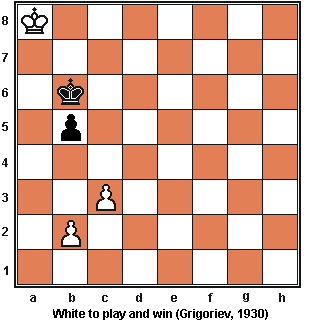Problem (Grigoriev, 1930)

Grigoriev Problem Solution:
1.b3! (1.Kb8? b4! draws, when 2.c4? b3! even loses for white. Also 1.b4? Ka6! is a draw as black has the opposition and can always follow the white king).
1� Ka5 (if Ka6 2.b4! wins as now white has the opposition and can outflank the black king i.e. 2� Kb6 3.Kb8 and if Kc6 then 4.Ka7 or Ka6 then 4.Kc7)
2.Kb8! (2.Kb7? b4! draws, as 3.c4 is stalemate) b4 (Kb6 3.b4 is the same as above) 3.c4 Kb6
4.Kc8 Kc6 5.Kd8 Kd6 6.Ke8 Ke6 7.Kf8 Kf6 (black has to prevent white�s king getting off the back rank. He can�t try to grab the b3 pawn as white�s c pawn will promote first) 8.Kg8 Kg6 9.Kh8!
Black can no longer keep a vertical opposition with Kh6, as then his king would be too far away to stop the white c pawn.
9� Kf6 (diagonal opposition) 10.Kh7 Kf7 (horizontal opposition) 11.Kh6 Kf6 12.Kh5 Kf5 13.Kh4 Kf4 14.Kh3 (now black cannot maintain horizontal opposition with Kf3 as again his king would be too far away to stop the white c pawn) 14� Kf5 15.Kg3 Kg5 16.Kf3 Kf5 17.Ke3 Ke5 18.Kd3: finally black cannot maintain vertical opposition, so white is now ready to play Kd4 and c5, winning.
|
|

